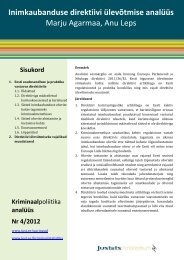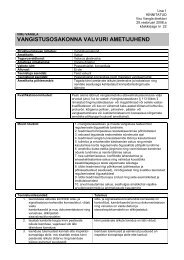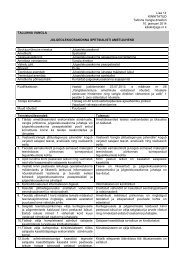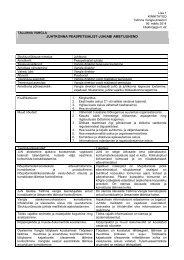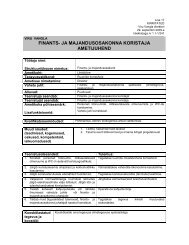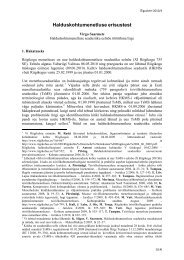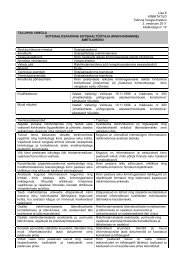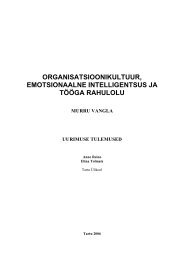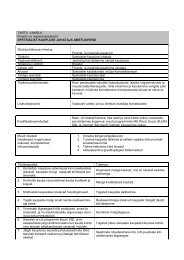11. Retsidiivsus Eestis - Justiitsministeerium
11. Retsidiivsus Eestis - Justiitsministeerium
11. Retsidiivsus Eestis - Justiitsministeerium
Create successful ePaper yourself
Turn your PDF publications into a flip-book with our unique Google optimized e-Paper software.
RETSIDIIVSUS EESTIS 2010<br />
5. RECIDIVISM OF PEOPLE RELEASED FROM PRISON AND FACTORS INFLUENCING IT<br />
RETSIDIIVSUS EESTIS 2010<br />
Figure 28. The proportion of people who committed a new criminal offence of any<br />
type within 12 months after release by the type of prior criminal offence and year<br />
of release from prison (%)<br />
By types of criminal offences the picture is similar also within two years after release<br />
- the recidivism of people punished for theft has been steadily the highest (67%).<br />
of the similar type as the criminal offence committed before. In case of several<br />
types of criminal offences (especially in case of sex crimes) the total number<br />
of people is small and therefore the indicators are not sufficiently reliable for<br />
making definite conclusions.<br />
People who were in prison for manslaughter and released in 2004-2006<br />
did not commit any new criminal offences of the same type during the observation<br />
period (2004-2008) and these are not shown on the figure. The only<br />
person repeating a criminal offence of the same type was punished for murder<br />
and he was prematurely released in spring 2007 after serving a 7 year sentence.<br />
He committed a new manslaughter nearly ten months after release.<br />
A criminal offence of the same type as before was most frequently committed<br />
by people punished for theft (within one year 26%-35% and within two years<br />
40%-43%); they were followed by people punished for repeatedly driving a<br />
vehicle while intoxicated (respectively 6%-16% and 23-29%). In case or thefts<br />
the amendments of law related to petty thefts may have influenced the statistics<br />
to a small extent63.<br />
People punished for sex crime or drug crime committed relatively infrequently<br />
a criminal offence of the same type again (within two years not more<br />
than 6%). No clear trends in the comparison of people released from prison in<br />
different years become evident.<br />
Table 9. The proportion of people released from prison who committed a new<br />
criminal offence of any type within 24 months after release (by the type of prior<br />
criminal offence and year of release from prison, %)<br />
2004 2005 2006<br />
Manslaughter 21% 25% 18%<br />
Violence 58% 51% 60%<br />
Sex offence 42% 51% 21%<br />
Drug offence 42% 37% 46%<br />
Theft 67% 67% 67%<br />
Robbery 58% 55% 55%<br />
Fraud 59% 56% 62%<br />
Drunk driving 60% 48% 49%<br />
5.4. Repeated commission of criminal offences of the same type<br />
by people released from prison<br />
Next, it is described how big proportion of people released from prison<br />
committed within one up to four years following the release a criminal offence<br />
Figure 29. The proportion of people who committed a new criminal offence of the<br />
same type within 12 months after release (by the type of prior criminal offence and<br />
year of release from prison, %)<br />
63 From 15 March 2007 to 27 July 2008, a theft of objects of small value (less than EEK 1000) was punished<br />
due to lack of aggravating circumstances only as a misdemeanour pursuant to § 218 of the Penal Code, not<br />
depending on the number of incidents. On 28 July 2008, a provision of the Penal Code entered in to force (§<br />
199, sub-section 2, clause 9) according to which regardless of the size of caused damage, beginning from the third<br />
theft the act constitutes a criminal offence (regular theft).<br />
204<br />
205



